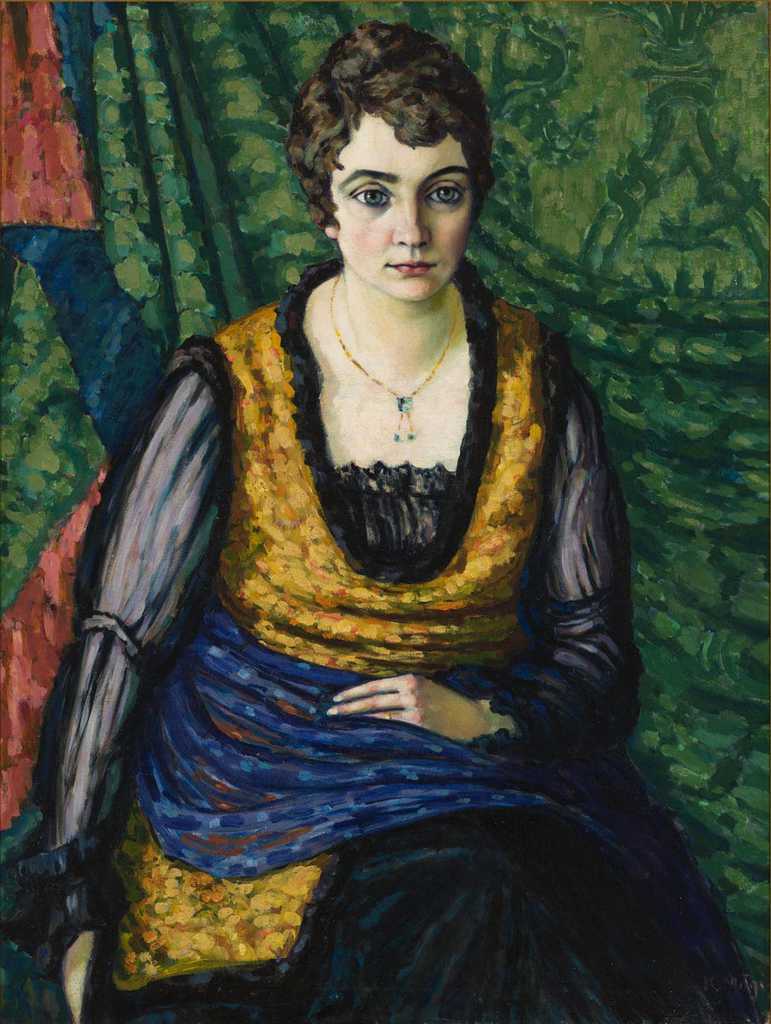
1919 was an important year for Alvi(i)ne Rosalie Käppa in a number of ways. She had turned 40 that summer, and it is possible that it was on the occasion of her birthday that she posed for this portrait by Konrad Mägi.
There are a number of possible paths that led to Alvine Käppa and Mägi meeting. For instance, we know that the Käppa family lived in places connected to Mägi’s childhood, Hellenurme and Uderna – one of the Käppas was even the school teacher at the school in Uderna. Yet Alvine Rosalie’s husband Gustav hailed not from Uderna but Valga. For Gustav as well, 1919 had been a significant year because his sports equipment factory was up and running again that spring for the first time since a wartime hiatus. Little by little, they started producing masks for fencers and skis for skiers, and dozens of workers once again manned the lathes that for a while had turned out combat vehicles and field beds for the front lines. Gustav had founded a sports equipment factory because he himself was sports-minded and sat on the board of the Taara Sports Society – an organization that Mägi had joined in his youth but which Mägi, who had returned from abroad in fitful health, would scarcely have continued to be active in. Käppa was also an enthusiastic participant in politics and cultural life; he had been elected a city official in Tartu that same year and belonged to the Vanemuine Society. It is possible that this hard-working and likely wealthy man developed personal contacts with Mägi in Tartu, a relatively small city, and that he commissioned a portrait of his wife.
There is also another possible explanation. Namely, Alvine Käppa was related on her mother’s side to the Kangropool (Kangro-Pool) family, which included a number of people in art circles. Among her cousins were Voldemar and Rasmus Kangro-Pool. The painter and graphic artist Voldemar was very active on the art scene of Tartu in the 1910s and undoubtedly had close interactions with Konrad Mägi. For example, both Voldemar Kangro-Pool and Mägi were among the 10 who signed the charter of the Pallas Art Society in 1918, which evolved into the art school of the same name by October 1919. His brother Rasmus worked as a journalist for Postimees newspaper in those days, focusing on art policy.
Thus, there are a number of ways that Alvine and Konrad Mägi could have met for this painting. We know that the work was later owned by Rasmus Kangro-Pool’s family, but since extremely little is known about the life of Alvine Käppa, it is hard to surmise why the painting ended up with the model’s cousin.
Similarly to other female portraits, Mägi also transforms Alvine Käppa into a Madonna-esque fantasy. He again places special emphasis on painting the face, especially large eyes and glowing cheeks. Mägi has piled different articles of clothing on the surface of the painting, which allow him to explore problems of colour and form. In 1919, Mägi finished his large composition called Pietà (the work has been lost) and in a number of preliminary versions of this work, he concentrates on ways of depicting various folds of clothing. The depiction of women in mourning is also key in Pietà, but since they were painted in profile there, it is hard to conclude that the portrait of Käppa was part of the preparatory cycle for Pietà. This portrait is also one of the few known works where Mägi uses the green tone familiar from his landscapes to colour the background. The necklace around Alvine Käppa’s neck is modest but nevertheless an accessory bespeaking wealth, allowing conclusions about her social status and Mägi’s contradictory attitude to stratification. Known for his leftist views in his youth, the artist also organized provocations intended to shock the bourgeoisie later in life, but also painted portraits of upper middle class people on many an occasion.